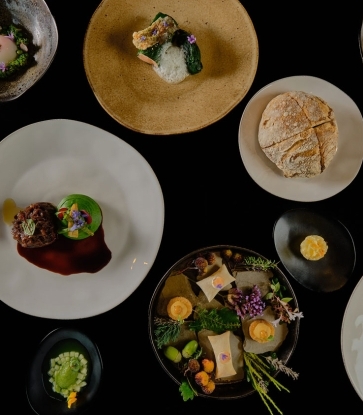Berries in purple, yellow and orange hues; tiny little apples; oblong red-and-green citrus fruits; and glistening succulent leaves that are covered in what looks like frost. They have names like muntries, quandongs, riberries, saltbush, finger limes and crystal ice plant.

These are just some examples of the native bush foods—or, bush tucker—of Australia’s aboriginal people. And though they have been consumed for centuries, they burst into the international spotlight when Noma’s René Redzepi relocated his restaurant to Sydney for a 10-week stint in 2016, creating a menu around these indigenous ingredients, sparking the conversation about Australian cuisine.
“We’re all aware that we should be using native ingredients more, but we want to make sure we are using these ingredients in a more thoughtful way so it won’t become a cliché,” says Aussie chef Clayton Wells of Sydney-based Automata and Blackwattle in Singapore.

“There was a time in the late 90s when you’d go to an Australian restaurant and you would have kangaroo, mashed kumara, a native pepper berry and some Hibiscus sauce. It was very cliché; people stopped using this sort of stuff for a while because of that. It’s important to use this produce in the right way, instead on just piling it on a plate, because it doesn’t work out like that.”
Even in Australia where these ingredients are from, they are most times unheard of, overlooked, or, at best, a novelty at restaurants. While some, like salt bush or finger limes, have become more mainstream, farmed and sold in markets or even exported, this seemingly exotic produce grows in many Australians' backyards without them even knowing.
“Take riberries, for instance,” says Wells. “My parents have a farm up in Gippsland in southern Victoria, and my dad said to me last week: ‘Lilly pillies? You want lilly pilly berries? I have about 25 lilly pilly trees in my backyard.’ And he doesn’t know what to do with them. That happens a lot—it’s just a plant in the backyard and food for the birds.”

Riberries are sweet and tart; Wells incorporates them into a dessert of barley ice cream where its acidity and almost cinnamon-like spice sits well with the flavors of rhubarb and vanilla. “As you taste these, you’ll understand their flavor profile. These are very sour, and you know that rather than seeking vinegar or other things to get acidity, you can use these to get a burst of freshness,” he says. “It’s about having these ingredients at the back of your head, so you can use them thoughtfully.”



















